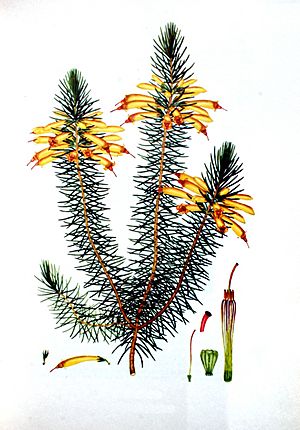Henry Cranke Andrews facts for kids
Quick facts for kids
Henry Cranke Andrews
|
|
|---|---|
| Nationality | British |
| Scientific career | |
| Fields | Botany |
Henry Cranke Andrews (fl. 1794 – 1830), was an English botanist, botanical artist and engraver. As he always published as Henry C. Andrews, and due to difficulty finding records, the C. was often referred to as Charles, until a record of his marriage registration was found in 2017.
He lived in Knightsbridge, and was married to Anne Kennedy, the daughter of John Kennedy of Hammersmith, a nurseryman who assisted Andrews in the descriptions of the plants he illustrated.
He was an accomplished and unusual botanical artist, in that he was not only the artist but also the engraver, colourist, and publisher of his books in an era when most artists were only employed to draw plates. The Botanist's Repository was his first publication; issued serially in London in ten volumes between 1797 and 1812, the Repository at a half-crown an issue, provided affordable images of plants to the growing population of amateur gardeners in Britain. This was the first serious rival to the Kew publication, Curtis's Botanical Magazine.
Andrews' major work is considered to be his Coloured Engravings of Heaths, published in four volumes between 1794 and 1830. It focused on the many species of the genus Erica that were introduced to Great Britain from South Africa in the early and middle 19th century, leading to what has been called an "Erica mania" in British horticulture.
Henry Andrews reportedly named the Australian flowering plant Correa after the Portuguese botanist and polymath, José Francisco Correia da Serra, who was living in exile in England from 1795 to 1797, and who pursued research with their mutual colleague Joseph Banks.
According to a contemporary announcement, Andrews also taught drawing from nature and etching to private students.
[[Category:Botanists|]]
See also
 In Spanish: Henry Cranke Andrews para niños
In Spanish: Henry Cranke Andrews para niños


